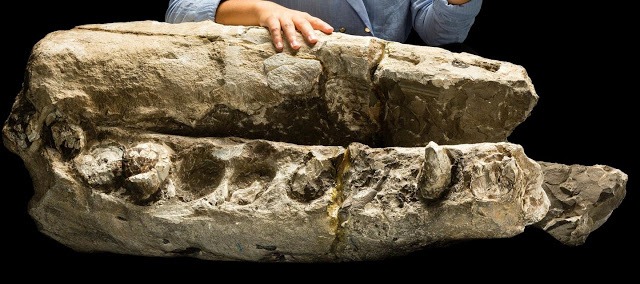| Online: | |
| Visits: | |
| Stories: |

| Story Views | |
| Now: | |
| Last Hour: | |
| Last 24 Hours: | |
| Total: | |
Scientists Discover ‘White Whale’ Fossil: Researchers Re-Analyze 15-Million-Year-Old Sperm Whale Fossil, Find ‘White Whale’
In this reconstruction, a pod of Albicetus travel together through the Miocene Pacific Ocean, surfacing occasionally to breathe. Modern sperm whales are also known for forming these tight-knit groups, composed mainly of females and their calves.

Credit: A. Boersma
The authors of the study reanalyzed the large but incomplete Ontocetus oxymycterusfossil sperm whale specimen from the middle Miocene Monterey Formation of California, originally described in 1925 by Remington Kellogg. Kellogg put this species in the genus Ontocetus, that was originally thought to be a tooth taxon; however, it is now known that in this genus, species have walrus tusks instead of a cetacean teeth. Thus, the authors assigned this species to the new genus Albicetus, creating the new combination of Albicetus oxymycterus, gen. nov. The authors used the term “Albicetus,” or “white whale,” because they were inspired by the fossil’s bone-white color, in homage to Melville’s famous fictitious leviathan Moby Dick.
Research student Alex Boersma with the type fossil specimen of Albicetus oxymycterus, composed of the beak and lower jaws of the whale. The specimen is about 14-16 million years old.
Credit: Jame Di Loreto, Smithsonian.
“This find means that, around 15 million years ago when there were a lot of large sperm whales with big teeth like Albicetus, it may have been a moment of peak richness in the number and diversity of marine mammals serving as prey to these whales,” Boersma suggests.
Contacts and sources:
PLOS ONE
Citation: Boersma AT, Pyenson ND (2015) Albicetus oxymycterus, a New Generic Name and Redescription of a Basal Physeteroid (Mammalia, Cetacea) from the Miocene of California, and the Evolution of Body Size in Sperm Whales. PLoS ONE 10(12): e0135551. http://dx.plos.org/10.1371/journal.pone.0135551
Source: http://www.ineffableisland.com/2015/12/scientists-discover-white-whale-fossil.html




